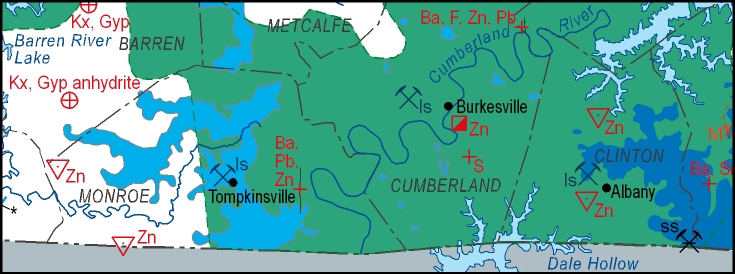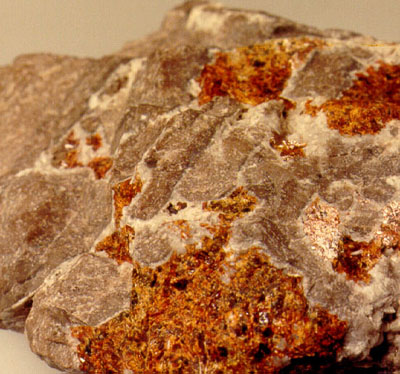South-Central Kentucky Mineral District
Mississippi Valley-Type Mineral Deposits
Zinc deposits in the Knox Group of south-central Kentucky and Middle Tennessee are classified as Mississippi Valley-type (MVT) ore deposits. These deposits are associated with the Knox erosional unconformity and solution-collapse breccia features, and the suite of minerals usually includes sphalerite, galena, fluorite, and barite, with calcite and quartz gangue. These deposits are about 2,000 feet in depth, and several major mining companies have explored them to determine their mineability.(Anderson, 1991) This mineralization is similar to the Middle Tennessee zinc deposits that were commercially mined at Elmwood and Carthage.

Surface mineralization in south-central Kentucky is also associated with vein deposits. The surface deposits are tabular and extend into the Knox along north-trending faults, fractures, and joints.
Zinc mineralization is widespread in the Knox and occurs throughout the Mascot Dolomite and in parts of the Kingsport Formation. It appears to be concentrated within several zones within the Mascot that are related to limestone units or limestone equivalents, however ore zones are most common near the M-3, M-d, CMS, C-Mot, and D-Wispy marker beds (detailed information on the marker beds is available from the KGS Minerals Database). The mineralization favors primary porosity such as stromatactis zones between algal structures, breccia bodies, and other open space fillings. The facies contact between limestone and dolomite and the vugular porosity of the stromatolites acted as conduits for migrating basinal fluids in the study area. Breccia formation in the Mascot Dolomite generally has been recognized as being caused by thinning, dissolution, and collapse of limestone or evaporate units. Sphalerite mineralization occurred after the development of the Knox unconformity in secondary porosity zones in the late-stage breccias. These bodies extend vertically and laterally within the Mascot. Facies relationships, paleokarst, brecciation, and structural highs influenced hydrothermal basinal brine movement and zinc mineralization. The accumulation of hydrocarbons in the upper Mascot was related to the M-5 marker bed. This marker bed was related to a paleoaquifer and an impermeable cherty unit that were good hosts for oil deposits.

Kentucky's two major zinc deposits are located near Burkesville in Cumberland County and near Foundation Run in Monroe County. Extensive core drilling has defined both ore bodies; the Fountain Run deposit is stratigraphically lower (near the base of the Mascot Dolomite) than the Burkesville deposit. It was in this region of favorable structural and paleotopographic features that Cominco American opened an exploration shaft in 1978 to explore the Burkesville deposit. The shaft was 2,000 feet deep, and several drifts were opened on ore levels. High levels of hydrogen sulfide gas made mining difficult, and low ore grades (2 to 3 percent) prevented the mine from being an economic operation. Other smaller breccia bodies and ore reserves were discovered in the area, but none of these were developed into mines.
